
|
Włodzimierz Rączkowski
Expansion and reaction: the concept of Polish archaeology
in the discourse with German archeologists
|
Conceptions,
myths, and stereotypes about the past, created by historians focusing
on the differences between 'ours' and 'theirs', have influenced
the feeling of separateness in the attitude towards neighbouring
societies, peoples and nations. Archaeologists have also participated
in the process of raising the national identity. It can be seen
in the influence of ideology and politics on the way questions
have been formed in archaeology, in the choice of research issues
and also in the interpretation of prehistoric phenomena. Among
the subjects taken up by Polish archaeology, the problems of the
Slavs and their relationships with Germanic tribes, together with
the origin and development of the Polish state under the reign
of the Piast dynasty, have been of the utmost importance in the
process of creating national identity. Depending on the changes
in the political situation and on cultural and social demand,
the function of the issues mentioned above has differed and phenomena
from the remote past have been differently emphasised and interpreted.
Complex relations (national, economic, social, religion) between
Poles and Germans in the history give us examples of cultural
expansionism and reactions on it. Therefore it is worth asking
whose activity might be interpreted as expansion and whose as
reaction?
Expansion is usually
understood as an act or process of expanding territory. We can
distinguish at least two types of expansionism: international
(according to the definition) and intra-cultural (between groups
and people within the society).
According to the commonly
accepted stereotype, the state of Poland or the Polish people
have always taken a defensive approach in the Polish-German conflict
resulting from the German eastern policy. Analyzing the nation-creative
processes in the territory of Poland, the political views connected
with them and the contribution of archaeologists, one can also
perceive a distinct anti-German tendency apart from the defensive
aspects. Such approach resulted from the centuries-old Polish/German
proximity and convictions shaped by history. Concepts, ideas,
ways of interpretation were expressed by the all kind of means
by different people or groups of people to expand them. The 'material'
evidence of the approaches might be identified in archaeological
texts - papers, books, ways of interpretation of archaeological
record - as well as popular publications, school textbooks, posters
etc.
Archaeologists seldom
expressed their patriotic intentions (in archaeological texts)
and stressed the objectivity of their knowledge. Their attitude
and standpoints were certainly determined by many factors. The
cultural context from which they originated, in which they lived
and worked, must have been of remarkable importance. |
| 1. Poland after the Treaty of Varsailles |
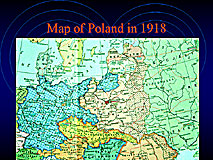
fig. 1 |
The
conclusion of the Great War led to the revival of Poland in 1918.
The western Polish borders were approximately similar to those
from before 1772. The eastern border, however, was approximately
as it had been in 1793 after the second partition of Poland. Only
in the north-eastern part of the borders was there a major difference.
This border was affected by the creation of the independent state
of Lithuania, as a result of which
Poland had suffered |
| a considerable loss of her eastern provinces
as compared to the situation before 1772. Moreover, the new Poland
was not nationally homogeneous. Within the new Polish territory
there were also Ukrainians, Byelorussians, Lithuanians, Germans
and Jews. The eastern border divided provinces which were previously
considered Ukrainian, Byelorussian and Lithuanian. The historical
capital of Lithuania, Vilnius, as well as Lvov, a city of up most
importance to Ukrainians, were also within the Polish borders.
The fact that both Vilnius and Lvov played a substantial role
in Polish tradition and culture only complicated the situation.
The situation in the
west of Poland was entirely different. The agreements of the Versailles
Conference did not fulfill the ambition of many Polish politicians
and journalists. They were also aware of the menace that could
be caused by the frustration of the German politicians after a
considerable loss of the former eastern German provinces. An article
in 1921 by B. Jakimiak in the daily newspaper "Gazeta Warszawska"
was just an example to show that from the very beginning of the
independence of the Polish state the western border had not been
accepted and a justification to move the border to the west should
have been sought: |
"The
border that we have been presented with in the west does not give
us any security. Neither the River Piaśnia nor the River Obra
should be our western border, but the Odra River and its left
tributaries as the old Piast border. East Prussia ought to be
taken from our back as a constant peril to our territories and
included in Poland, and Lithuania should comprise the part with
Lithuanian people." |
It
was commonly accepted that it was not feasible to change the borders
in the then political and international situation. However, it
did not mean the abandonment from actions which, in the long run,
could create better conditions for the eventual annexation of
Silesia, East Prussia and Pomerania to Poland. Acting according
to international law as far as the minorities were concerned,
there were three options to tackle: |
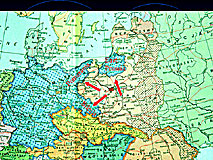
fig. 2 |
| 1) |
to keep in the minds of Poles
living in Germany the conviction that the then existing Polish/German
borders were only temporary and they must change for Poland's
benefit, |
| 2) |
to raise the national consciousness of Poles
in Germany and make them impervious to many actions of Germanization,
|
| 3) |
to create the pattern of culture and demography
which would consolidate the inter-relationship between the provinces
in Germany and Poland regarded as Polish from historical and ethnic
viewpoints. |
At
first the Germans did not accept their eastern borders agreed
in Paris either. They demanded that the borders be revised and
the German minority in Poland protected. They also put great emphasis
on the national consciousness of their countrymen living in the
Polish territories. This led to irrevocable conflicts and disagreements.
The temperature of the discussions was increasing or decreasing
in tune with current political relations between Poland and Germany.
Archaeologists did not miss the opportunity to take part in the
discussions, bringing in relevant and substantial evidence. |
| 2. Archaeologists supporting politics |
After
the Great War, Polish archaeologists, for the first time, could
work in the fully-fledged, entirely Polish scientific institutions.
Important archaeological centers were established in Warsaw, Cracow,
Lvov and Poznań. Besides, the fact that the latter center played
a significant role in the archaeological sphere, it was also the
main center of the Polish 'western studies'. This was a simple
result of experience from the partition period and a general anti-German
attitude of Polish society in the Wielkopolska region.
The Polish-German discussion
on ethnic issues in prehistory was the continuation of the discussion
from before the Great War. Shortly after the discussion had been
commenced, it acquired an emotive and nationalistic character.
Professor Józef Kostrzewski, the Polish archaeologist from Poznań
University was deeply involved in the discussion as a Polish representative.
|
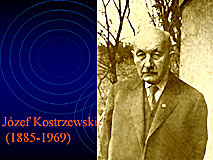
fig. 3 |
Józef
Kostrzewski lived in the years 1885 - 1969. He earned his reputation
and esteem thanks to his huge scientific output which has had
permanent influence on the form of Polish archaeology. His ideas
affected the consciousness of Polish archaeologists in the field
of research problems as well as in methods of solving them. Kostrzewski
did not formulate any expressis verbis of methodological assumptions
which could have |
been found dominating in his studies. However,
an analysis of his work lets us assume that he used positivistic
ideas in his research. Acquisition of excavated materials, which
are "pure" facts, their description and arrangement, is the basis
for scientific research. Material which has been scientifically
analyzed in this way is the source of objective knowledge about
the past. The purpose of archaeology, in this aspect, is to reconstruct
history of humanity in all aspects of human life, that is first
and foremost, ethnic and political as well as economic, social
and spiritual aspect. With reference to Polish territories Kostrzewski
recognized the role of archaeology in the cognition of |
"(...) the remotest political past and the
record (...) of immemorial settlement (...) of our ancestors (e.i.
Slavs) in the tributaries of the Odra and the Vistula rivers (...)". |
He
studied archaeology with Gustaf Kossinna as his tutor. We may
assume therefore, that he knew Kossinna's method and with certain
modifications he applied it in his attempts to prove the autochthony
of the Slavs. His thesis of the autochthony of the Slavs in the
tributaries of the Odra and the Vistula was the leading idea tackled
in all his scientific, didactic and popularizing activity. He
was emotionally committed to the problems of the Polish western
borders and the situation of the Poles in Germany. He often published
articles in newspapers defending the Polish character of Silesia
and Pomerania. An excerpt from Kostrzewski' s diary concerning
the situation in 1928 clearly shows his political attitude: |
"Thus(...) facing the fact that in a short
time we will have to fight the decisive battle with the Germans
for Pomerania, it is essential to draw attention to the fact that
Poland not only does not have to give anything back to the Germans
but also has some genuinely Polish provinces to take back. In
addition, it was not Germany that lost in the Treaty of Versailles
but Poland which regained only a part of provinces plundered from
Poland in the partition period, while the rest was given to Germany,
seemingly as a bonus for effective Germanization in these provinces
." |
These
controversial views provoked a great number of polemics among
the German archaeologists. The scientific polemics were stirred
up mainly by Józef Kostrzewski on the Polish part and Bolko von
Richthofen on the German part. Violent polemics between Kostrzewski
and von Richthofen would not have had any greater significance
in creating national identity of the Poles (Slavs) on the Polish/German
border if they had taken place exclusively on a scientific level
and in scientific literature. However the major part of the discussion
was led by articles which were published in newspapers and popular
scientific magazines and brochures. It was this kind of discussion
that influenced the creation of conceptual stereotypes of the
Germanic people and the Slavs. Several titles of articles by Bolko
von Richthofen and Józef Kostrzewski will let us visualize the
"tone and temperature" of the discussion. |
| Bolko von Richthofen (selected publications from years 1925-1935): |
* Ist Posen urpolnisches Land?
* Ist Oberschlesien urpolnisches Land?
* Oberschlesien Urzeit auf Grund der Bodenfunde
* Gehört zur Urheimat der Polen? Kritik der vorgeschichtlichen Forschungsmethoden
an der Universität Posen
* Ministerpräsident Kozlowski gegen Professor Kostrzewski
* Prof. Kostrzewski sieht Gespenster
|
| Józef Kostrzewski (selected publications from years 1927-1936): |
* O naszych prawach do Śląska w świetle pradziejów tej dzielnicy
(Of our rights to Silesia in the light of its
prehistory)
* O moralne zdobycie Pomorza w opinii świata (Of moral conquest
of Pomerania in the opinion of the world)
* Z działalności Ostlandinstitutu (From the archives of Ostlandinstitut)
* Vorgeschichtsforschung und Politik. Eine Antwort auf die Flugschrift
von Dr. Bolko Frh. von Richthofen: Gehort Ostdeutchland
yur Urheit der Polen (Prehistory and politics.
A reply to Dr von Richthofens article)
* Czy wyniki polskich badań prehistorycznych godzą w całość Niemiec?
(Do the results of Polish prehistoric research
damage the German integrity?)
* Czy Śląsk jest krajem pragermańskim? (Is Silesia a pre-Germanic
country?)
* Historiozofia hitlerowska a prahistoryczne teorie Kossinny (The
Nazi philosophy of history and Kossinna' s theories
on prehistory)
* Baron Bolko von Richthofen jako apostoł porozumienia polsko-niemieckiego
(Baron Bolko von Richthofen as the apostle of
the Polish-German agreement)
* Badania archeologiczne w Niemczech mają przygotować rewizje granic
(Archaeological research in Germany gives grounds
for the revision of borders)
* Prehistory of Polish Pomerania |
It
is worth noticing that both sides of the discussion did not use
only scientific arguments to prove their points. Emotions and
personal attacks were also in common use. At the harshest moment
of the heated discussion a diplomatic intervention became indispensable
in order to lower the temperature.
It seems that Kostrzewski
was entirely aware of the role that historical tradition played
in cultural and national identification as a base for expansion.
Bearing this in mind we can pinpoint at least two aspects of the
discussion between Kostrzewski and von Richthofen. The first one
was undermining the scientific value of the works of some German
archaeologists and the second was the popularization of the knowledge
about the common Slavic past amongst the inhabitants of the frontier
provinces (Wielkopolska, Silesia and Pomerania). Moreover, the
popular scientific lectures given outside Poznań and courses for
teachers in Poznań was yet other method of spreading Kostrzewski's
views and reaching the whole range of social groups. |
The
discovery of a settlement from the Late Bronze Age/the Early Iron
Age in Biskupin (north-western part of the Wielkopolska region)
in 1933 was of immense scientific and propaganda importance. This
very well preserved fortified settlement of the Lausitz Culture
made great impression on archaeologists, politicians and ordinary
people. The visits of Polish government and church dignitaries,
scientists and artists brought the |
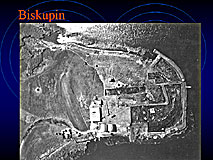
fig. 4 |
excavations to the attention of the public.
They demonstrated to Polish and foreign public opinion the right
of Poland to that territory. Thus they questioned the German claims
to their revindication. Lectures on the inhabitants of Biskupin
stirred up listeners' imagination. The high level of civilization
of Biskupin's settlers was expressed by a very fine arrangement
of the settlements' buildings and the quality of craftsmanship.
Where could one find a better argument to show everyone that the
level of civilization of the Slavic people inhabiting the tributaries
of the Odra and Vistula rivers was no lower than the general level
of development in central and northern Europe? Owing to Kostrzewski
and his colleagues' popularized scientific activity, this interpretation
of Biskupin became a well known symbol of the prehistoric culture
of Poland's ancestors. |
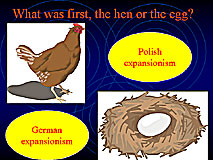
fig. 5 |
It
is hard to indicate who can be described as 'expansionist' and
who only reacted on the outer expansion. The complicated Polish-German
history as well as verity of aims of different politicians in
the history. Both historians and archaeologists of both sides
were involved in the process of creating national identity and
it was the base to formulate the aims for political expansion.
I can not agree with the thesis that Polish people have always taken |
a defensive approach in the Polish-German
conflict resulting from the German eastern policy. Both Polish
and German politicians (and archaeologists) represented expansionism
(there were exceptions of course) and both reacted on it. Any
attempt to answer the question: who does formulate the first program
of expansion and who does react on it is like a searching for
an answer the question: what was the first, the hen or the egg? |
One
can ask a question: Why was German approach not accepted by the
majority of Polish archaeologists and by Polish public opinion?
To answer the question we have to understand theoretical background
of archaeology, its place in the system of sciences and the role
of an authority within the subject. On the other hand the system
of education and school curricula were part of the system creating
concepts, stereotypes and myths on the historical relations between
Poles and German. |
| 1. Expansion of concepts across the society - Polish archaeologists |
Kostrzewski's
conception of methodology of archaeology can be defined as rational
pseudotheoretical historism. Acquisition of excavated materials,
which are "pure" facts, their description and arrangement, is
the basis for scientific research. Material which has been scientifically
analyzed in this way is the source of objective knowledge about
the past.
Kostrzewski accepted
the basic assumptions of Kossinna's method, however, he introduced
some modifications. Kostrzewski's considerations concerning relations
taking place between an archaeological culture (that is, material
culture) and ethnos were, to a large extent, influenced by inspirations
which had originated from linguistics, physical anthropology and
ethnology. Kostrzewski's enormous factographic knowledge enabled
him to notice that numerous archaeological cultures show striking
homogeneity in the whole area of their existence. It concerns
such cultures as the Corded Ware Culture, the Lausitz Culture
or the culture of the Slavs in the Middle Ages. Kostrzewski explained
this homogeneity with the fact that peoples which had created
these cultures were interconnected and stayed in close contact.
Such close relations amongst peoples of the same or similar material
culture were possible providing they spoke the same language.
Thus, Kostrzewski assumed that |
"(...) a precisely defined archaeological
group of compact range, corresponds with a certain ethnic unit
speaking one language". |
However,
it was not evident that every archaeological culture is a counterpart
to a separate ethnic unit. But, what differentiates Kostrzewski
from Kossinna most, is Kostrzewski's statement that it is possible
that |
"(...) successive archaeological cultures,
which are interconnected by numerous common features, can represent
various stages of development of the same ethnic unit. Different
archaeological cultures can undergo more or less significant changes
of their character under the influence of external factors such
as economic and social transformations, but without changes of
population. The changes, however, will never be so radical as
to make it impossible to refer a new phase of development of the
culture to the previous one or one culture to a later one which
originated from it. Therefore, we can regard the continuity of
culture as the proof of the continuity of habitation by the same
population. Strong changes within a culture or even a replacement
of one culture for another one in the same territory will not
always prove changes of population if only there are relevant
elements linking these cultures together and their ranges are
consistent." |
Searching
for connections among successive archaeological cultures we give
evidence of the permanence of habitation in a given territory.
In this way, Kostrzewski drew our attention to the phenomenon
of duration of certain elements in cultures, as opposed to the
then dominant tendency of concentrating research efforts on changes
of cultures. |
Kostrzewski,
in his studies on the continuity of Slav's presence in the tributaries
of the Odra and the Vistula rivers used the retrogressive method.
Since the first written sources confirming the presence of Slavs
in the mentioned territories came from the early Middle Ages,
Kostrzewski took this period as the basis in his studies.Comparison
of data concerning products of a material culture from the early
Middle Ages (7th - 10th century) with |
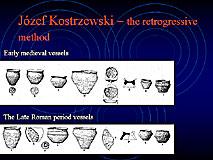
fig. 6 |
a directly preceding it archaeological culture
(that is from the period of Migrations and the Przeworsk
Culture from the period of the Roman Iron Age) and display of their
similarities would be the evidence for the presence of Slavs in
the tributaries of the Odra and the Vistula rivers as early as
in the Late Iron Age. Continuing such studies on earlier cultures,
it is possible to prove the "age-long" presence of Slavs and pre-Slavs
in the present Polish territories.
In the process of realization
of the research postulate, Kostrzewski accomplished a very profound
comparative analysis of products of a material culture from the
early Middle Ages, period of Migration and the Roman Iron Age.
He compared forms of pieces of pottery, their ornamental features,
metal objects (mainly iron), objects made of stone and bones,
forms of dwelling places, caves and barrows. The conclusion which
resulted from the research was as follows: |
"The only correct conclusion resulting from
the above mentioned conformability among various elements of material
and spiritual culture of the Roman and early mediaeval periods,
is the assumption, that in the Roman Iron Age in the Polish territories
lived ancestors of the same people who lived there in the early
Middle Ages, that is, pre-Slavs". |
| The Przeworsk Culture was its archaeological counterpart. |
|
fig. 7 |
fig. 8 |
|
fig. 9 |
fig. 10 |
Kostrzewski,
then, took up studies which went further into the past. He, again,
compared certain chosen elements of a material culture from different
periods - this time from periods of the Roman Iron Age (the Przeworsk
Culture), the La Tene and the Hallstatt periods as well as from
the Bronze Age (the Lausitz Culture). He took forms of pieces
of pottery, iron and bronze products as objects of the comparison.
The conclusion Kostrzewski reached this time was the following:
the fact that there are plenty of relations among successive archaeological
cultures, is the proof of the continuity of habitation in the
territories of the Odra and the Vistula rivers at least from the
beginning of the Lausitz Culture, that is, from the beginnings
of the 3rd period of the Bronze Age. Therefore, it was univocally
proven by Kostrzewski that the Lausitz Culture is the archaeological
counterpart of pre-Slavs.
Kostrzewski was not
looking solely for archaeological arguments to justify the continuity
of habitation in the tributaries of the Odra and the Vistula rivers.
He willingly made use of physical anthropology data which were
to give the reasons for fundamental constancy of physical anthropology
on the mentioned area from the Neolithic to the early Middle Ages.
Linguistic data appeared to be of vital importance in Kostrzewski's
research as they proved the survival of typical Slavic onomastics
referring to geographical terms and names of plants used already
by people of the Lausitz Culture. Moreover, Kostrzewski used studies
on the kinship of Indoeuropean languages. He carried out comparative
research on contemporary ethnographical borders of archaeological
cultures. All arguments proved cultural continuity from the 3rd
period of the Bronze Age to the early Middle Ages.
Kostrzewski's views
and research procedures provoked vivid discussions mainly among
German archaeologists whereas they became a standard in Poland.
There were a few attempts to undermine Kostrzewski's concept.
The system in which position of almost all archaeologists in Poland
depended on the Kostrzewski's opinion cramped Polish archaeologists
in searching for other solutions and method of investigation.
The only theoretical approach (cultural-historical archaeology)
which was acceptable that time made impossible any other interpretation
of archaeological record. The power of Kostrzewski's method of reasoning
in archaeology have affected research activities in Poland for
years.
Kostrzewski and his
role in Polish archaeology are a part of the social context in
which archaeology developed. He had an impact on: |
| 1) |
creating basic categories of archaeological analysis |
| 2) |
recognition of data either reliable or incredible |
| 3) |
recognition of procedure of scientific verification either correct or incorrect |
| 4) |
recognition of states either fictional or factual |
| 5) |
building an atmosphere of 'scientific character' according to some projects |
| 2. Expansion of concepts across the society - Polish public opinion |
Popularization
of the special type knowledge about the common Slavic past amongst
the inhabitants of the frontier provinces (Wielkopolska, Silesia
and Pomerania) was one of the form of expansion across the society.
Kostrzewski actively participated in the process. He used to give
popular scientific lectures outside Poznań and taught at the courses
for teachers in Poznań.
The idea of courses
for teachers was introduced in order to propagate knowledge about
the preservation of archaeological finds. In addition, the program
of the courses covered rudimentary knowledge of Polish prehistory.
Kostrzewski took part in such courses as a lecturer and presented
his views and opinions on |
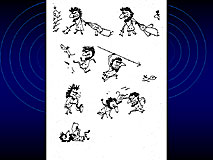
fig. 12 |
the issue of the autochthony
of the Slavs. The popularization of the knowledge of the prehistory
of the Slavs was of outstanding importance since school manuals
did not contain any information about Polish prehistory. But in
school textbooks Germanic people were described as warriors whereas
the Slavs were said to be of rather peaceful nature. A few excerpts
from high school manuals clearly show it: |
"The Germanics were most of all warriors.
Wars provided them with the majority of their daily needs; their
tribes lived in permanent conflict and fighting; the notion of
violent vengeance was the ruling principle to everybody, that
is, the whole clan was obliged to take revenge on the killer of
a member of their community or on the whole clan of the killer;
thus war was the everyday reality for the Germanics. (...) Agriculture,
the cultivation of soils was reluctantly dealt with by the Germans;
the young usually left farming to women and the old while they
took advantages of the toil and booty of wars." |
"The Slavs' nature was straightforward,
sincere; when in peace they did not know neither dirty tricks,
larceny nor cheating; they were characterized by wholehearted
hospitality which was experienced by all travelers and writers." |
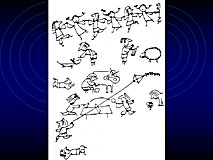
fig. 13 |
Once
more I can say that the discovery of a settlement in Biskupin
was of immense importance. Lectures on the inhabitants of Biskupin
stirred up listeners' imagination. The high level of civilization
of Biskupin's settlers was expressed by a very fine arrangement
of the settlements' buildings and the quality of craftsmanship.
Where could one find a better argument to show everyone that the
level of civilization of the Slavic people inhabitating the tributaries
of the Odra and Vistula rivers was no lower than the general level
of development in central and northern Europe. This interpretation
of Biskupin became a well known symbol of the prehistoric culture
of Poland's ancestors. |
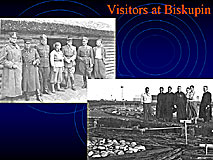
fig. 14 |
The
visits of Polish government and church dignitaries, scientists
and artists brought Biskupin to the attention of the public. Biskupin
was depicted in art works and in novels which recreated the aspect
and everyday life of this pre-Slav' settlement. In one of the
novel we can find words as follow: |
"We can proudly state that even in so distant
a past our ancestors had a fine material culture. If, later on,
its normal development was checked, it was the outcome of attacks
by foreign plunderers who for many centuries wronged the naturally
peace-loving Slavic farmer." |
The propaganda as well as stereotypes present
in school textbooks influenced the way of understanding the past
by the public. Still it is hard to discuss the Slavic status of
Biskupin. |
| 3. Conclusion: expansion as a tool of power |
Expansion
is closely linked with power. Power is relevant to complicated
relations in society and it cannot be reduced to individuals or
social groups within specific fields of activity, such as economics
or politics. Power and expansionism may take different forms and
shapes. The relationships of power and expansionism are interrelated
and entangled depending on differentiated social practice. They
may be related to the interests of individuals and social groups
involved at both ends of the processes of exploitation, domination
or submission. They are present in all social relations because
all members of a given community are, more or less, involved in
relations with material (technology, raw materials) and immaterial
(knowledge, information, skills) cultural resources. Both power
and expansionism are in dialectical relation to these cultural
resources.
One of the most important
aspects of power discussed by Foucault is the power - knowledge
relationship. From the point of view of archaeology this relationship
is of paramount importance since it is related to the 'archaeologist
context' and the influence on the created narratives about the
past and their social consequences. Knowledge is constructed within
a specific social system and it is dependant on the conceptual
patterns prevalent in the system. On the other hand knowledge
contributes to the strengthening of these patterns and to the
change of relations and contexts. In this way knowledge is present
within the system of relations which encompasses social experience
of power.
Studying the forms of
expansionism both in international relations and domestic affairs
we can and should explore variety of sources of information which
are available in archives, e.g. minutes of scientific and political
meetings (to understand the process of undertaking decisions),
unpublished papers, letters, diaries, posters, leaflets etc. |
|







